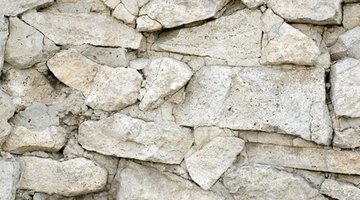How to Color & Age a Limestone Wall
Stacked limestone walls---outdoors in a garden or indoors on a fireplace---provide a note of rustic beauty to any design. Limestone can come in a variety of natural colors---gray, tan, yellow---or a combination of all three. If you want to give your limestone wall a single, unifying color, you can stain the stone with a colorant compound, available at most landscape supply stores or online. You can also use colorants to artificially "age" limestone by adding tell-tale streaks of green to represent the development of moss.

-
Purchase stone colorant products, not "color enhancers." Color enhancers revive the stone's natural colors. You want to change the color altogether. Read the package carefully so you're sure to get the right product. You can use colorants meant for "concrete" staining on limestone walls.
-
Study the directions for the product carefully before proceeding and gather all the recommended tools for the job ahead of time. Limestone is extremely porous and you won't have time to "stop" the recoloring process to fetch another tool.
-
Clean the limestone surface with a power sprayer, with the sprayer head set on "broad" or "wide." Don't use a fine setting: you could accidentally etch the stone. Let the stone dry completely before proceeding, unless your product directions tell you to apply the product to wet stones.
-
Pour the "base color" (gray, tan or yellow) colorant product into a clean spray applicator bottle. Set the nozzle to "wide." Spritz the product onto a test stone (or a less visible area of the wall or walkway). Let the product settle onto the limestone for a few minutes, or according to the product recommendations. Since limestone is so porous, longer "setting" times will usually increase the color effect. Wipe off any excess colorant with a thirsty fabric rag.
-
Evaluate the effect of this first trial "setting" time. If the color isn't deep enough, apply a second coat and let it set longer before wiping it off. If the color is too deep, reduce the setting time and test this theory on a second trial stone.
-
Color only two or three stones at a time across the wall until the entire project has been treated with the base colorant. Let the colorant dry completely.
-
Pour a green-toned colorant product into another empty spray bottle. Set the nozzle on "narrow" or "fine." Choose areas along the wall where you want to apply faux moss to the surface of the stones. To make this choice, think of the behavior of real moss. Real moss on a wall follows a path of water as it flows down the face of the wall and so cascades down stones in an inverted pyramidal shape. The top stones on the walls will have the most moss, and the width of the moss will taper as the moss goes lower on the wall.
-
Spray the green "aging" faux moss color on the stones and let the color set for a pre-determined amount of time. Wipe away any excess. Let the color dry.
-
Gently rinse the limestone with a garden hose, not a power sprayer. You will likely remove the colorant you just applied if you use a power sprayer.
-
Apply a sealant if your colorant product recommends it, and do so according to the product directions. Sealants generally retard fading of colors due to water and sun.
References
- "Stonework: Techniques and Projects"; Charles McRaven; 1997
- "Stonescaping Idea Book"; Andrew Wormer; 2006
- "Walks, Walls, and Patios"; Creative Homeowner; 2004
Tips
- Look at pictures of aged limestone walls for keys to what aged limestone looks like.
Writer Bio
A writer and entrepreneur for over 40 years, J.E. Myers has a broad and eclectic range of expertise in personal computer maintenance and design, home improvement and design, and visual and performing arts. Myers is a self-taught computer expert and owned a computer sales and service company for five years. She currently serves as Director of Elections for McLean County, Illinois government.
Photo Credits
- limestone wall texture image by starush from Fotolia.com
More Articles



